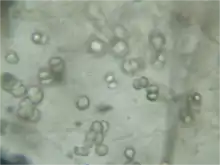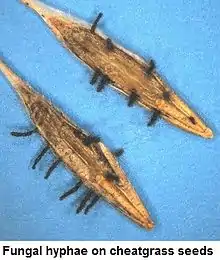| Pyrenophora seminiperda | |
|---|---|
 | |
| Pyrenophora seminiperda spores | |
| Scientific classification | |
| Domain: | Eukaryota |
| Kingdom: | Fungi |
| Division: | Ascomycota |
| Class: | Dothideomycetes |
| Order: | Pleosporales |
| Family: | Pleosporaceae |
| Genus: | Pyrenophora |
| Species: | P. seminiperda |
| Binomial name | |
| Pyrenophora seminiperda (Brittleb. & D.B. Adam) Shoemaker, (1966) | |
Pyrenophora seminiperda is a minor plant pathogen that causes leaf spots on many grasses.[1] It is an important generalist grass seed pathogen[2] which causes visible cylindrical masses of black fungal hyphae (stromata) to grow from infected seeds. Hence the common name "black fingers of death"[3]

It has been hypothesized that the fungus arrived in North America with invasive grasses from Eurasia.[4] BFOD has been suggested as a method of biocontrol of the invasive cheatgrass, one of the most important invasive species in the USA.[3][5] Various secondary metabolites of the fungus, including Cytochalasin B, Pyrenophoric Acid-B, and Spirostaphylotrichin W, appears to be responsible for the seed killing.[6][7][8]
References
- ↑ Medd, RW; Murray, GM; Pickering, DI (2003). "Review of the epidemiology and economic importance of Pyrenophora semeniperda". Australasian Plant Pathology. 32 (4): 539–550. doi:10.1071/AP03059. S2CID 26067172.
- ↑ Beckstead J, Meyer SE, Ishizuka TS, McEvoy KM, Coleman CE (March 7, 2016). "Lack of Host Specialization on Winter Annual Grasses in the Fungal Seed Bank Pathogen Pyrenophora semeniperda". PLOS ONE. 11 (3): e0151058. Bibcode:2016PLoSO..1151058B. doi:10.1371/journal.pone.0151058. PMC 4780786. PMID 26950931.
- 1 2 Meyer, SE. "Cheatgrass Biocontrol with "Black Fingers of Death"". www.fs.fed.us. USDA Forest Service. Retrieved 21 February 2017.
- ↑ Boose, D; Harrison S; Clement S; Meyer S (2011). "Population genetic structure of the seed pathogen Pyrenophora semeniperda on Bromus tectorum in western North America". Mycologia. 103 (1): 85–93. doi:10.3852/09-310. JSTOR 27920465. PMID 20943557. S2CID 10058827.
- ↑ BARRINGER, FELICITY (2012). "Out West, 'Black Fingers of Death' Offer Hope Against an Invader". New York Times. Retrieved 21 February 2017.
- ↑ Masi M, Evidente A, Meyer S, Nicholson J, Muñoz A (2014). "Effect of strain and cultural conditions on the production of cytochalasin B by the potential mycoherbicide Pyrenophora semeniperda". Biocontrol Science and Technology. 24 (1): 53–64. doi:10.1080/09583157.2013.844769. S2CID 33374513.
- ↑ Masi M, Cimmino A, Clement S, Black B, Evidente A (2014). "Pyrenophoric Acids B and C, two new phytotoxic sesquiterpenoids produced by Pyrenophora semeniperda". Journal of Agricultural and Food Chemistry. 62 (42): 10304–10311. doi:10.1021/jf5035515. PMID 25264583.
- ↑ Masi M, Clement S, Andolfi A, Cimmino A, Evidente A (2014). "Spirostaphylotrichin W, a spirocyclic γ-lactam isolated from liquid culture of Pyrenophora semeniperda, a potential mycoherbicide for cheatgrass (Bromus tectorum)". Tetrahedron. 70 (7): 1497–1502. doi:10.1016/j.tet.2013.12.056.
External links
Dr. Erin Mordecai discusses BFOD and Cheatgrass during a seminar at the Department of Ecology and Evolutionary Biology at University of Michigan, Feb. 16, 2017